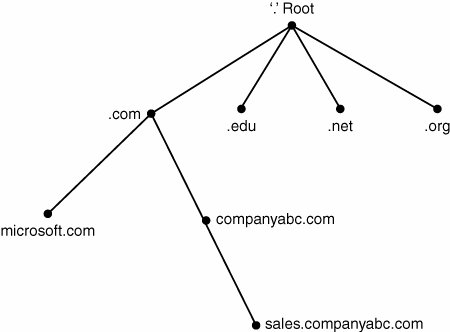Framework for DNS
| DNS structure is closely tied to the structure of the Internet and often is confused with the Internet itself. The structure of DNS is highly useful, and the fact that it has thrived for so long is a tribute to its functionality. A closer examination of what constitutes DNS and how it is logically structured is important in understanding the bigger picture of how DNS fits in Windows Server 2003. DNS HierarchyDNS uses a hierarchical approach to name resolution in which resolution is passed up and down a hierarchy of domain names until a particular computer is located. Each level of the hierarchy is divided by dots (.), which symbolize the division. A fully qualified domain name (FQDN) such as server1.sales.companyabc.com uniquely identifies a resource's space in the DNS hierarchy. Figure 9.1 shows how the fictional CompanyABC fits into the DNS hierarchy. Figure 9.1. DNS hierarchy. The top of the hierarchy is known as the root, and is represented by a single . (dot) that is managed by the main Internet Registration Authority. Moving down the DNS hierarchy, the next layer in the model is made up of .com, .net, .gov, .fr, and similar domain namespaces that loosely define the particular category that a domain namespace fits into. For example, educational institutions are commonly given .edu extensions, and commercial businesses are given .com extensions. These extensions form the first set of branches to the DNS tree. The second level in the DNS hierarchy commonly contains the business name of an organization, such as companyabc in Figure 9.1. This level is normally the first area in the DNS hierarchy where an organization has control over the records within the domain and where it can be authoritative. Subdomains can easily be, and often are, created in the DNS hierarchy for various reasons. For example, sales.microsoft.com is a potential domain that could exist as a sublevel of the microsoft.com domain. The DNS hierarchy works in this way, with multiple levels possible. The DNS NamespaceThe bounded area that is defined by the DNS name is known as the DNS namespace. Microsoft.com is a namespace, as is marketing.companyabc.com. Namespaces can be either public or private. Public namespaces are published on the Internet and are defined by a set of standards. All the .com, .net, .org, and similar namespaces are external, or public. An internal namespace is not published to the Internet, but is also not restricted by extension name. In other words, an internal, unpublished namespace can occupy any conceivable namespace, such as dnsname.local or companyabc.internal. Internal namespaces are most often used with Active Directory because they give increased security to a namespace. Because such namespaces are not published, they cannot be directly accessed from the Internet. |
EAN: 2147483647
Pages: 499
